        |
Lower Highland ParkHighland Park as it was laid out before 1900 was just what we call the "Upper Park" today. Lower Highland Park still had farmhouses on it as late as 1908, with the Schenck house lasting into the 1950s.
|
||
Did you know? - During the depression New York City used to bring portable theaters to the parks to put on shows? Note: This link is a pdf file that opens in a new window and requires Adobe Acrobat |
||
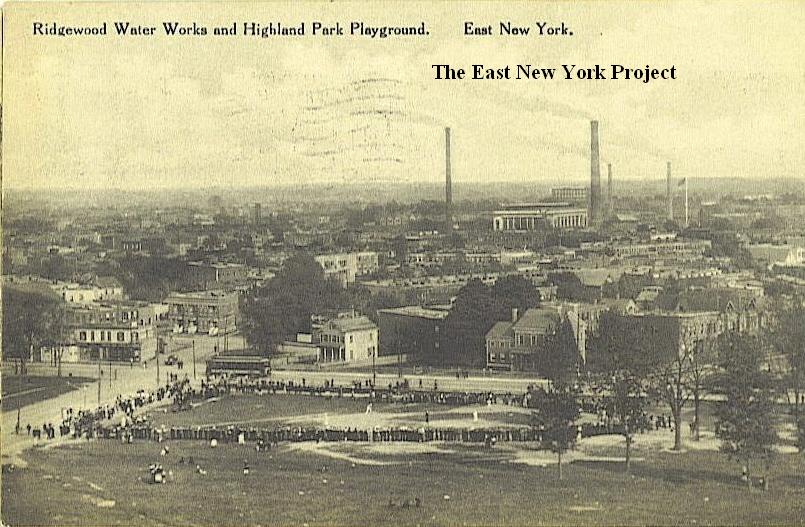 |
 |
Ridgewood Water Works and Highland Park Playground Dated:1915 Maker: Unk Status: Need We've misidentified some early postcards that this shot helped to clarify. Note the lack of trees along Highland Boulevard where it comes down to Jamaica Ave. Some other interesting elements; The YMCA is not there yet, that is the Rapelye House sitting on that corner. There are trees sitting in the "outfield" of the ballfield. Many thanks to fellow Brooklyn collector Ike for that scan. On the right is the last eastern strip of the park before the cemeteries shot by Neil Sullivan in 2006. It appears to be used as a dirt bike trail now. |
 |
 |
Snake Hill, East New York Dated:Unk Maker:Commecial Art Post Card Co. Status: Own(BG) A similar view, a little different angle, and it raises the question: what are those poles lining Highland Boulevard?. On the right, a 1950s color view from a similar angle, from Gloria Gallaway. |
 |
 |
Two shots on the far side of the park near Snake Hill and the cemetery. Peggy Solazzo sends in this shot of her folks, Lorraine and Dom Solazzo in 1948. Tim O'Reilly sent in this shot of his mother, also around 1948. |
 |
 |
Tim also sent these shots circa 1948. On the left we can see a car heading up Snake Hill in the background. The location of the shot on the right has us stumped; the fence in the background appears to be for the steps up to Highland Boulevard in the northeast corner, but we are not sure. |
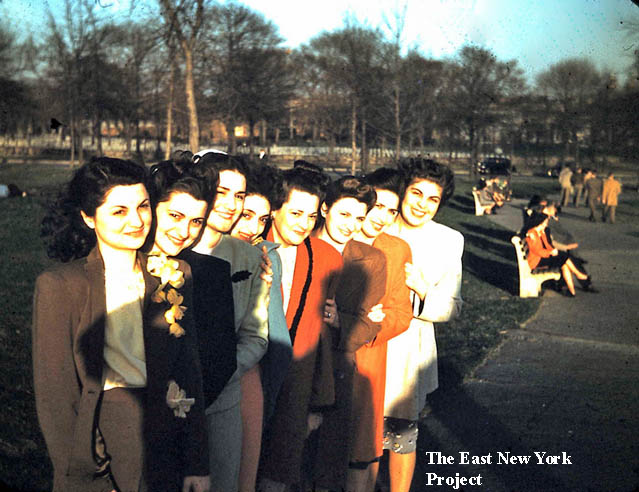 |
 |
Obviously a popular location for photos. That's my dad on the right, and we are reasonably sure it is the same view- east towards the wall for National Cemetery- as the other shots. The appear to be buildings in the distance which threw me off, but Peter Stangos color slide on the left, also from the 1940s, has more detail and there appear to be buildings in view as well. Left to right, his Aunt Rose Quagliarello, then her three sisters--Edith,Sue, and Tena. Next is Marion Ray(Edith's sister-in-law), then his Aunt Tommie, then Peter's mother and his Aunt Fran. |
 |
 |
From Gloria (Profeta) Galloway, a shot from the paths leading to the upper park, looking east toward National Cemetery. Gloria identified the couple as her neighbors, and the shot was taken in the 1950s.On the right , Ronnie amerise sent this 1948 image of his sister Rose. |
 |
"Montford House" One thing I enjoy is discovering poorly identified photos and getting the facts. This image from the BPL collection was only identified as "Montford House". I could easily recognize the park and have determined that the house was Abraham Snediker's. Snedikers farm encompassed all of Highland Park east of Cleveland Street, the reservoirs, and the cemeteries to Cypress Hills Road. The house passed to Washington Colyer, his son-in-aw, and then to A.W. Monfort, who was actually the milkman for the area. The house was part of the land purchase for Highland Park and was removed in 1908. It sat pretty close to where the current entrance is now, pictured below. |
|
 |
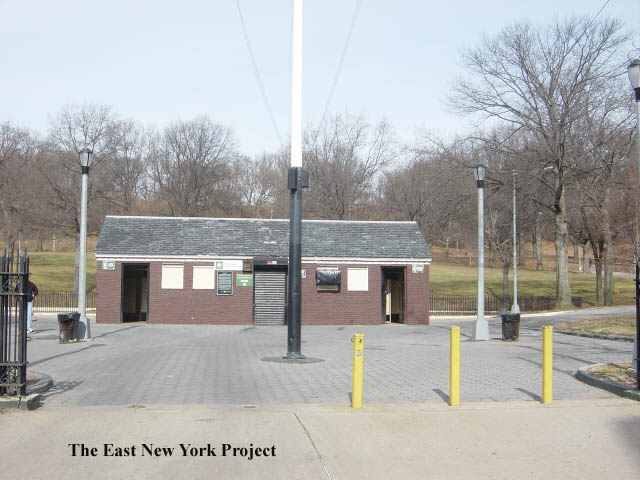 |
Mike Abney sent in this shot of his parents near the entrance in 1977. The update shot is from 2005 and Ronnie Amerise adds some background to the concession stand that used to be behind it. |
 |
Some folks may recall they used to put up a tree at the entrance around Christmas time, and on some evenings people would gather to sing carols. This shot is from one of those nights in 1966, featuring my brothers Bruce and Lou, myself, and cousins Tom, Rich, and John Cornell. Talk about how pictures trigger memories, I asked my mother (who can't remember a thing) why my brother Dennis was missing from the shot. "He was in a sour mood, and wouldn't smile", she recalled, "so I told him if he wouldn't get in the mood then get out of the picture." | |
|
It appears the Playground as we know it was opened Sept. 1, 1935 Sept. 1, 1935 NY Times article on new playgrounds in New York. |
||
 |
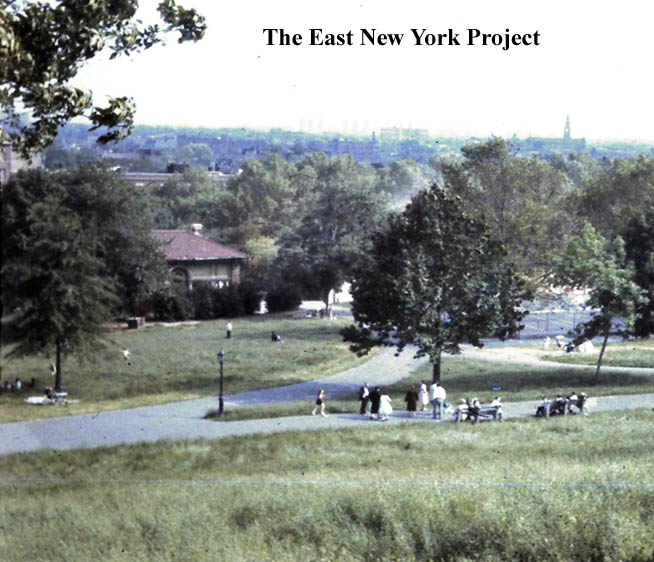 |
Scene at the Playground, Highland Park, East New York Dated:1917 Maker:Commercial Art Co. Status: Own(BG) I've posted a better scan of the old card. You can see the outlines of clay tennis courts on the right. The pavilion in the background was originally a clubhouse for those in the tennis club. Eventually it was converted to a park pavilion, with restrooms, first aid, and a concession stand. Judy Close adds; "The pavilion in the photos that used to be the old tennis club in my youth ca. 1950s, was called commonly, "the Rain House" because while still standing, it was boarded up, and if it began to rain while strolling in the park, people took shelter there." Ronnie Amerise confirmed for us the original pavilion had showers, lockers, and restrooms for the tennis players, but was closed by the time he started working at the park in 1956. It was demolished in 1957 due to vandalism. Gloria (Profeta) Gallaway provided this rare color view from the 1950s looking south with the pavilion still standing. |
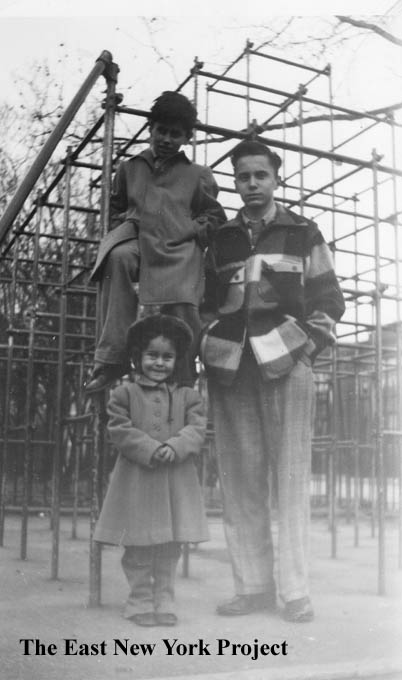 |
 |
Monkey Bars Couldn't possibly have a shot of HP without the monkey bars. On the left is a shot from the mid-1950s submitted by Gloria (Profeta) Gallaway. On the right, my cousins in 1967. Of course they weren't always safe; check out Jeanne Loriol's story. .  |
 |
 |
Monkey Bars, 1975 Cathy (Russell) DiBenedetto sent over a bunch of playground shot from April 1975. On the left, going clockwise from the top left is JoAnne Russell, Richard Russell, Jennifer Russell and an identified girl |
 |
 |
Kiddie swings From Cathy's shots, a view of the kiddie swings with Susan and Richard Russell, her cousins. Note the spikes atop the wrought iron fence which surrounded the playground; if you look at the 2005 photo you will note they have been all sawed down. |
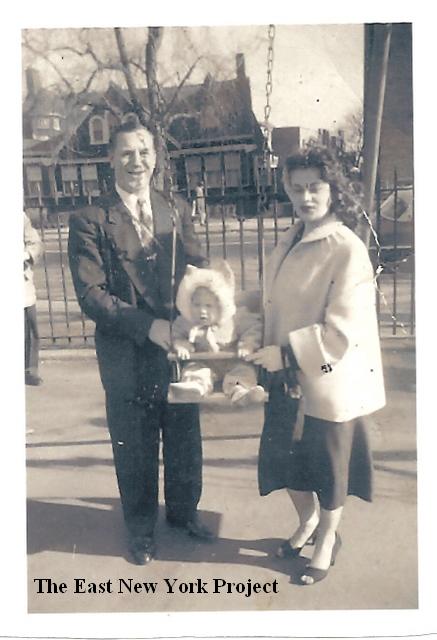 |
 |
The 1956 shot on the left is memorable because you can see the Stootholf House in the background; see Linwood Street for more. That's Mary Cornell, our unofficial historian, on the right. Elsie Anzalone sends over a 1960 shot with her daughter; great glasses! |
 |
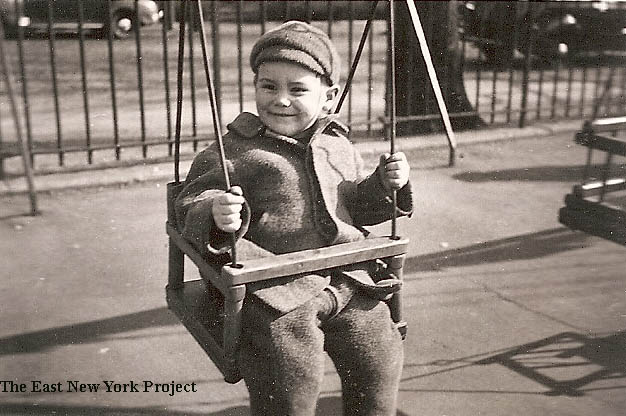 |
A great pair of shots of the original kiddie swings from Elise (Avella) Feiner. Pictured in 1943 are Edith Mainella with her two sons Warren and Joe, and they don't look too thrilled in that shot, but Joe seems pretty happy in the closeup where we can see the original swings were wooden. |
 |
Oddly Jack Russell also has a picture of himself on these wooden swings in 1943. That's his mother along with brothers Carson and Peter around him. | |
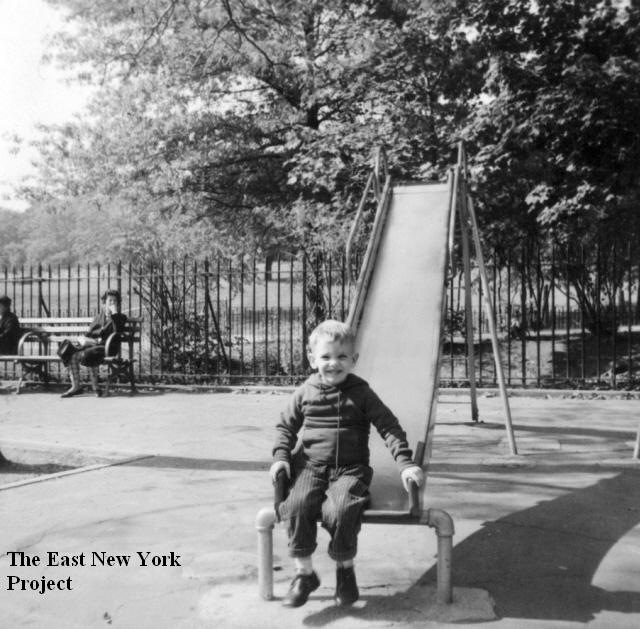 |
 |
Tony Davenport sent over this early 1960s photo of him on the slide and we both recall as kids that we referred to it as a "sliding pond". Does anyone know the history of that term? On the right, from Cathy's 1975 shots, thats Susan, unidentified, Jennifer, Joanne and Richard Russell top to bottom. |
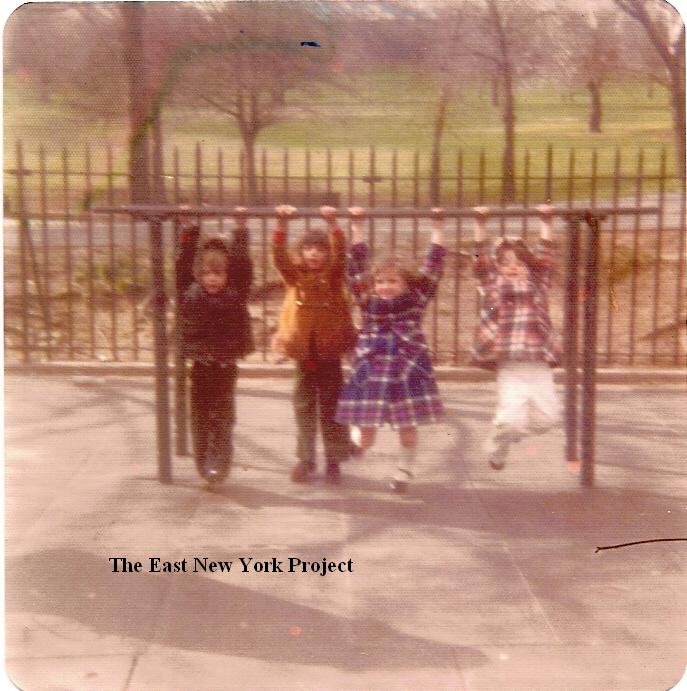 |
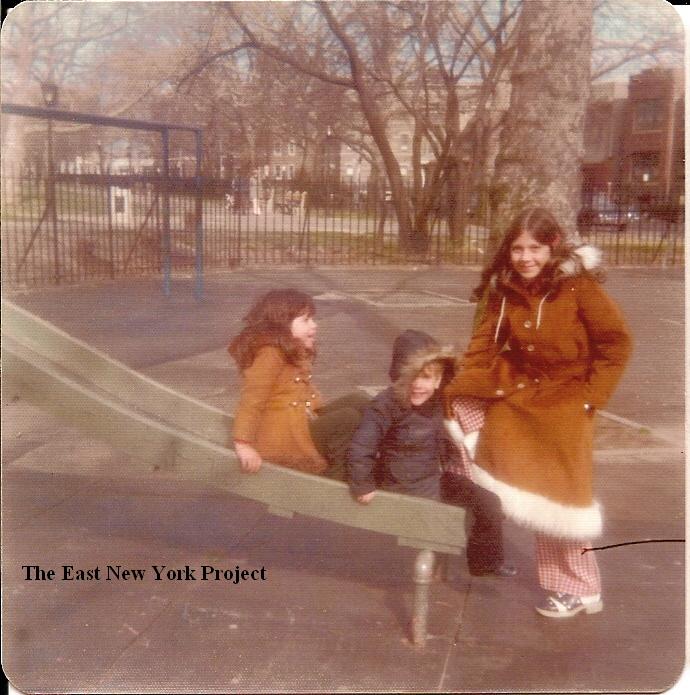 |
Cathy's collection included these shots of the 4 smaller children hanging from the parallel bars, and in the background of the second slide shot, the overhead parallel bars with horizontal ladders (Thanks to Ronnie for the proper name). All I can recall is my hands would burn after getting from end to the other! |
 |
Gloria (Profeta) Gallaway sent this picture taken in the 1950s of Jack Russell being slightly more adventurous on the parallel bars. | |
 |
 |
The shot on the right is of my cousin John in 1969 after they installed these colored cubes; I still don't know if it had a name. Though I had outgrown it at that point, I also couldn't help but notice the dirty puddles of water that filled it whenever it rained. This is no longer standing. About that time they also installed rubber mats. That's brother Gary on the left in the 1972 shot. |
 |
 |
An old 108 classmate of mine, Glenn Youngelman sent over this shot of the playground in the early 1970s. My brother took a similar shot circa 2005. |
 |
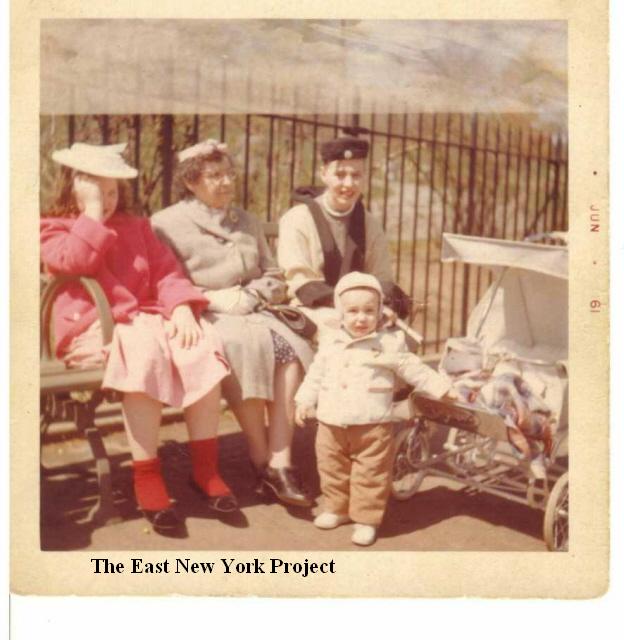 |
From the David Hays collection, a shot of the swings from 1967. Tim O'Reilly sent this 1961 shot but we're still debating the location; he theorizes it is across from the monkey bars, but I believe you can see the parkhouse in the background and they are sitting near the entrance. |
 |
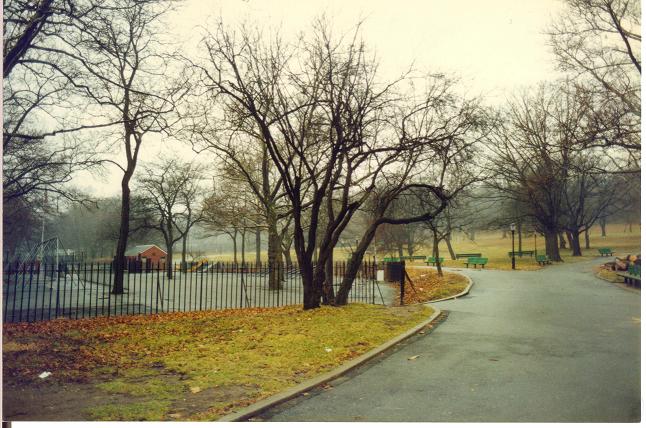 |
I finally found a seesaw shot, vintage 1972. Tim O'Reilly sent this 1990 shot of the park showing a view of an entrance on the eastern side of the playground which didn't exist in our day. |
 |
 |
Water foutains; Linda Feiling sent this 1953 shot of herself and on the right is a contribution from Tony Davenport at the water fountain, with his brother in the carraige. |
 |
 |
Uh, Tony, did you wipe that fountain? That's "Lance" in a 1952 photo, and a little bigger in the 1955 photo with Tony Marmo on the path heading towards the upper park. |
 |
 |
Ice skating was a popular early entertainment at Highland Park. In the early years they would flood the area where the ballfields now sit to form a rink. On the right is shot sent by June Marmo of herself in 1946; the fields are behind her and there appears to be some form of scoreboard. |
 |
 |
The Oval in Highland Park was used for many purposes. In the photo on the left, the oval was the center of a 50th anniversary celebration of Brooklyn's annexation to the city. The Oval had sprinklers to create a pool in the summer and a rink in the winter. Gloria (Profeta) Galloway sent the shot on the right of her ice skating in the 1950s. Check out Rod Maggio's hilarious story, then see below for another fond memory of the oval. |
 |
>  |
May Party in Highland Park, East New York Dated:1915 Maker: Commercial Art Post Card Co. Status: Have(BG) Every school kid remembers the maypole celebrations at Highland Park. They apparently have a long history, as the postcard on the left is from 1915. The photo on the right is from 1967.  |
 |
 |
May Pole Dance, 1972 I managed to uncover some better shots, see below for the actual Maypole dance. |
 |
 |
May Pole Dance It turns out I did have a photo, from the 1971 performance, of the Maypole. It was performed by the senior class. On the right, Mike Abney supplied a pic circa 1976. |
 |
 |
Oval, 1948 Cora (Gavin) Modica sent over this 1948 shot of her cousin and one of her brothers in front of the oval. On the right, Gloria Gallaway sent this view looking down on the oval in the 1950s. Ronnie Amerise noted you can also see the concession stand behind the park house. |
 |
Oval, 1945 Ronnie Amerise sent this shot of his sister Rosemary with the oval in the background in the 1940s. |
|
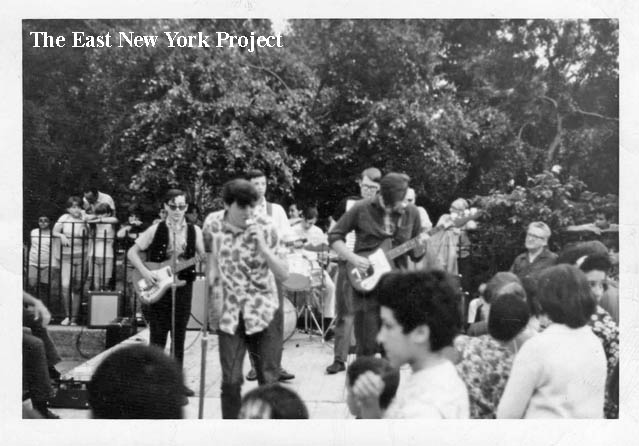 |
Friday's Children Courtesy of Kurt Eger, a 1960s shot of a Cypress Hills band, Friday's Children, playing in the oval. |
|
 |
 |
A couple of new photos as we move to the left of the main entrance. When we grew up the basketball courts were here, but now another playground sits in this area. The statue in the park entitled "Dawn of Glory" commemorates WWI heroes. It was dedicated July 12, 1924. Sculpted by Pietro Montana, Ronnie Amerise pointed out to me that Charles Atlas was allegedly the model for the statue. |
 |
 |
Tennis Courts The shot on the left shows the original courts dating to the 1920s. On the right is a still from 8mm footage shot in the early 70s. Click the video button to watch.  |
 |
 |
Tennis Courts 1967 Tennis was pretty big up at the park in the late 1960s. The park used to host some major youth tennis events, as seen in this 1967 photo. That's my cousins posing by the courts in 1967 on the left. |
 |
Vitas Gerulatis, Tennis Courts 1978 Ronnie Amerise sent this shot of tennis star Vitas Gerulatis at the HP courts with Cal Pergola in 1978. In his New York Times obituary (he died an accidental death in 1994) they said he first played tennis on the clay courts of Highland Park. |
|
 |
 |
Thanks to Gina Liccardo, who permitted us to borrow this image from her website. It is her mother performing with a band on the courts in the mid 1970s. Gina's family lived on Jerome Street and her brother attended PS 108 with my brother Lou. Gina offers both dance and massage therapy sessions through her website Letherapy. I added a 2007 view looking down at the courts. |
 |
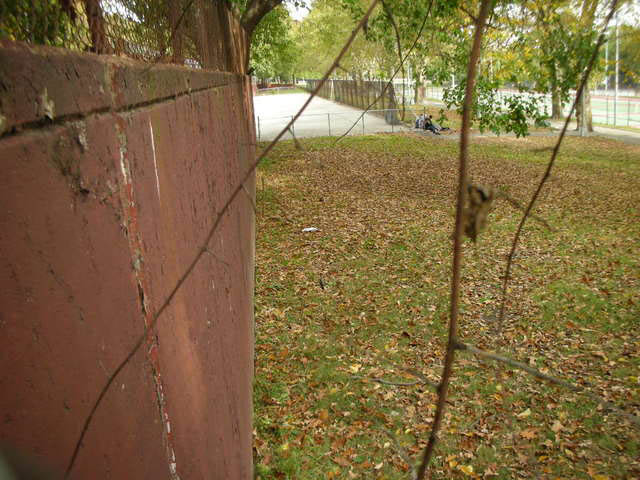 |
Thanks to Art Pirozzi, I have cleared up two mysteries. Art helped me track down the original development plans for the park in 1935. Those empty areas on either side of the handball courts, pictured on the right in 2008, were for horseshoe pits. The plans also confirmed the handball courts were built as part of the 1935 development of the lower park. I used to play a lot up there with my best friend Carl. It turns out his Dad and his uncle were both terrific players in their day, and Carl relayed a story about his uncle and the early days of these courts. |
 |
A rare shot behind the handball courts, circa 1968. That's Pat (Tromba) Werner in the tree and Elise (Avella) Feiner who sent in the shot. Although it was steep behind the courts, we used it in a pinch for baseball practice when we were shorthanded because the wall made a good backstop. | |
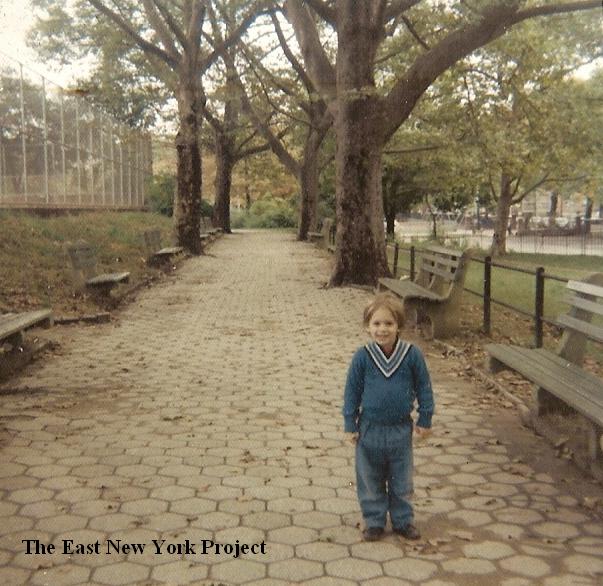 |
 |
On the left, a view east of the cobblestone paths which separated the tennis courts, the bocci courts and the handball courts. That's my brother Gary in this 1972 view. Gloria (Profeta) Gallaway supplied the great view on the right of the path seperating the clay and the hard courts. Behind her is the original tennis pavilion. |
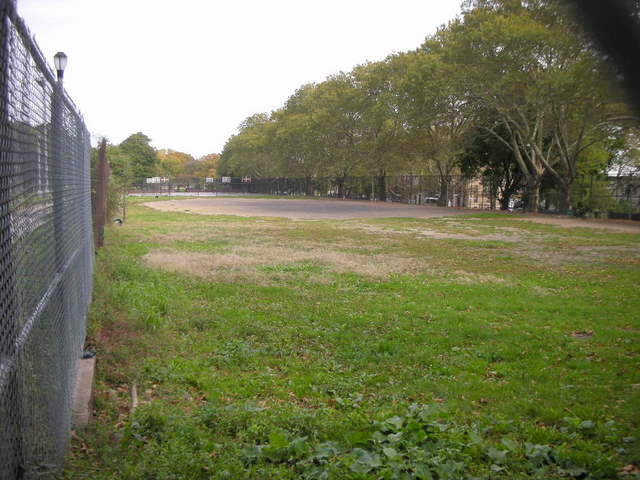 |
 |
From the 2007 update shot it appears the clay courts have been cleared. Joey Perrone supplied another update shot in 2009, when a soccer/football field was installed in this location. |
 |
 |
Schenck Homestead The Schenck family had a farm on part of the land where HP resides, and though it changed hands a few times, the house survived even after it became a public park. The location was near Ashford St on Jamaica Ave. The first photo is from an undated postcard. The second photo is from 1923. There is a seperate page devoted to the Schenck House here. |
 |
 |
Dawn of Glory This famous statue sits just east of the volleyball courts. Ronnie Amerise tipped me off that the bodybuilder Charles Atlas posed for the statue, and now Ronnie has provided the proof- an image of Atlas posing with the statue and the sculptor, Pietro Montana. The statue was a tribute to those members of the 22nd Assembly District who gave their lives during World War I. |
 |
Dawn of Glory dedication The location of the statue was the subject of debate. An early choice was the triangle of space formed by Jamaica and Ridgewood Avenues just west of Warwick Street, but it was vetoed by the Boro President and the Park became the logical location. The Brooklyn Daily Eagle reported 8,000 people attended the unveiling ceremony in July 1924, which was attended by the sculptor. |
|
 |
 |
Bocci Ball Courts One of the things that replaced the homestead was the bocci ball courts. The photo on the left is from 1963; when we were kids we used the courts for playing "running bases", a baseball rundown game. Oddly, I recall the italian men playing bocci all around the area near the courts, but not on them!. Chess tables were also in this area. Note in the 2005 photo the railings and water fountain are gone.  |
 |
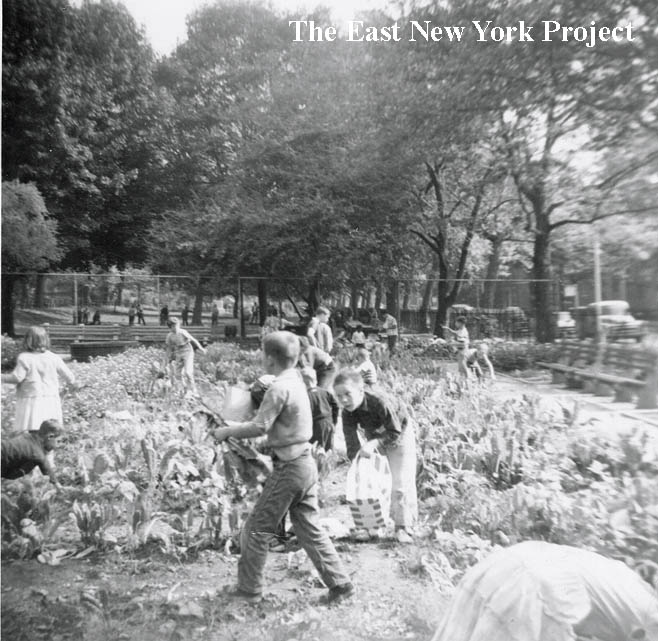 |
Children's Gardens Ronnie Amerise has supplied us with some great shots of the Children's Garden, which is still there. The one on the left is from the 1940a while on the right it appears top be late 1950s. Art Pirozzi found out for us that the garden was opened in 1916 and it was the third one opened in a New York park. My brother , as a P.S. 108 student, did some work in these gardens in the 60's. |
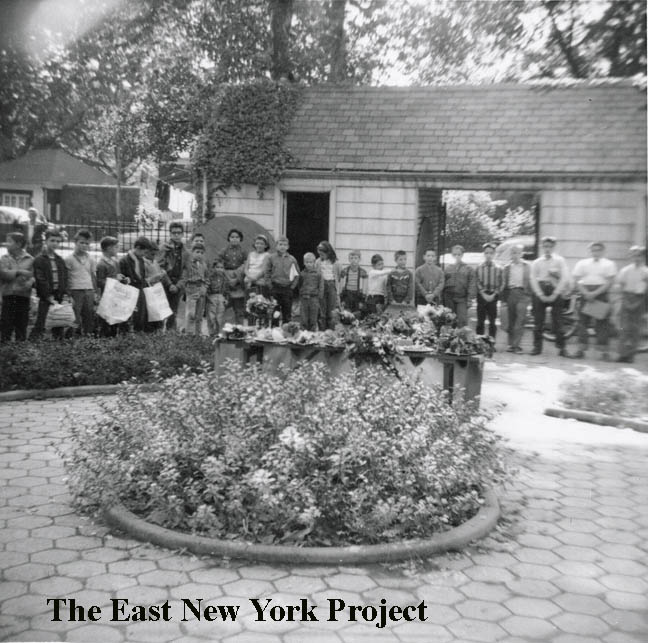 |
 |
Children's Gardens These terrific shots also come from Ronnie Amerise, who worked in the park starting back in 1956. The shot on the left in from 1962; on the right, 1957. Liz Jacks IDs her husband Alan Jacks from Sunnyside Avenue on the far right. |
 |
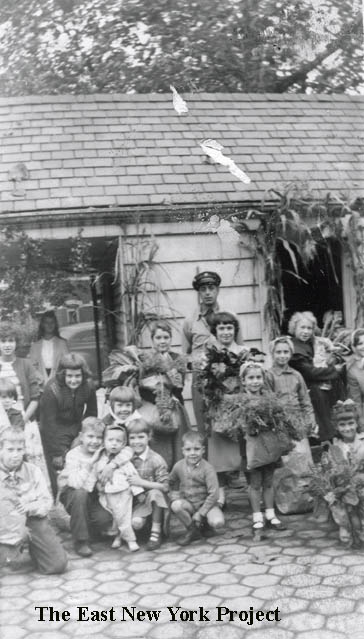 |
Children's Gardens On the right, a 1956 shot of the kids posing with with Park Gardener Ralph. Ronnie points out the Maple Leaf pin in his hat. |
 |
 |
The best sledding in Brooklyn, period. The older kids went all the way to the top and if you didn't get thrown off when you hit "the Hump", with enough speed you cross the ballfields and make the last dip to the fence before Jamaica Avenue. A long trek back too. I remember one year kids dragged a car hood up the hill and about eight of them came spinning down, though they didn't get very far. I've upgraded the original shots with these from 1972, with a view towards the top and the view down. |
 |
 |
More sledding pics; my cousins in 1966, and Mike Abney supplies a shot from 1978. Peter Murray relays a sledding story from earlier days. |
 |
 |
Sledding in the 1950s, courtesy of Gloria (Profeta) Gallaway. On the right Felix Orengo sends over a 1965 pic. |
 |
A real classic shot courtesy of Diane Moore Villaseca via JoAnn LaForte. This is lates 1960s/early 1970s. | |
 |
 |
Ballfields and YMCA When the snow was gone, of course we had the ballfields. In Cynthia Rongione's shot on the left, circa 1962, Cynthia is standing with her dad right by the hump alluded to in the sledding photos. In fact, Cynthia supplies her own story about her mother and that dangerous hump! On the right, a great color slide from Peter Stango, early 1940s. We can see the YMCA, the pumping station chimney, and even a trolley car on Jamaica Ave.  |
 |
 |
In these 1953 images, we see June Marmo's husband Tony carrying a golf club-which looks sinister until we realize what he is up to- giving golf lessons to the ladies! You can spot the YMCA water tower in the background. Both shots are circa June 1953 courtesy of June Marmo of course. |
 |
 |
East New York Vikings, circa 1975 This comes to us via Joey Perrone from Ron Basso, AKA "Dr. John". The team shot of course is in Highland Park, and the real challenge will be identifying the whole team. Joey is #24 and his brother Mike is#42 while Basso was #79, as can be seen in the second shot with some articles. John Rodriguez adds some IDs; "I am number 30 in the picture you have of the East New York Vikings. Basil Lodge is number 44. My nick name was Hollywood, the guys in the football team gave me that name. I was the guy that use to bring the wine in football equipment bag. Valley high lol. Leach , Neal Robert Rivera # 88 he is the one that is sticking his head all the way in the back. Wayne is next to Basil." |
 |
 |
East New York Vikings, circa 1975 Some closeup shots to help with IDs; on the left is the offense and on the right is the defense. Florence Harnos assists with 2 IDs on the offense; Peter Harnos ( Ridgewood Avenue) is number 26 and his friend Juan Fuentes (Chestnut Street) is number 43. Jack Donato recalls #61 as "Boobie". Barbara Schnell IDs Mike Olnick standing behind Joey Perrone(#24) on the defense. |
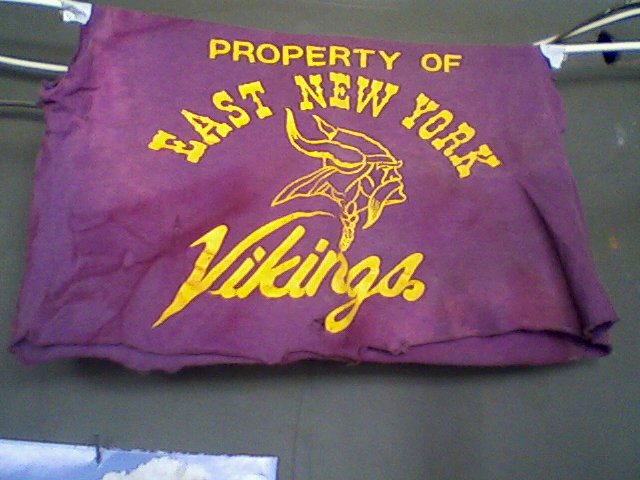 |
East New York Vikings shirt From Joey Perrone; "The Vikings sold these T Shirts to raise money for the team. I remember I had 3. This one is hanging in my brother Mike's garage. To my knowledge it is the last one in existence. In the old days I was able to walk to Pitkin and Cleveland to the team canteen ( Viking Headquarters) to attend dances on Friday nights. Without it I would never have made it outa there alive". |
|
| Highland Park Raiders, 1964-67 Gerry Carter supplies a roster, with addresses. We're looking for corrections and ommissions, as well as PICTURES! Tom Coffey – Coach (Also played Center for the Liberty Lions) Tom Andres – Quarterback (Norwood Street) Jimmy Coffey – Center Clifford Palmiteri (Biff) – Offensive Lineman (Essex Street) Mike Englese – Offensive Lineman (Crescent or Forbell Street) Jimmy Lacroix – Tight End (Essex Street) Jimmy Luciandro (Luc)– Running Back (Ridgewood Avenue) Dennis Gulliano – Tight End, Flanker (Hale Avenue) Jimmy Prizzi (Pappi)– Running Back (Essex Street) Jamie Russo (Rooster)Linebacker (Jamaica Avenue) Mickey Conroy – Linebacker (Essex Street) Frank Abbandando (Bac)-Defensive lineman (Essex Street) Eddie Correll – Middle Line Backer (Ridgewood Avenue) Gerry Carter - Defensive Lineman (Jamaica Avenue) Tom Mazzio Defensive Lineman (Norwood Avenue) John Casanova Defensive Lineman (Norwood Avenue) Dottie Messina – Cheerleader Rozz Landro – Cheerleader (Lincoln Ave.) Kathy – Cheerleader Michelle Romaglino – Cheerleader (Ridgewood Avenue) Mickalona Leoni (Mickey)Cheerleader (Pine St.) Karen Smedicki- Cheerleader Barbara&Karen Schroeder-Cheerleaders "Of course, back then; we had to play both Offense & Defense since we did not always have a full roster. I hope I spelled everybody’s name correctly. Ed Correll & I compiled this list from memory, so I hope we did not forget anyone else who played or were part of the team. If so, please let me know. Since we were not a league team and we waited for the league teams to finish their regular schedule, we played from December – March. We played against the Lynvetes of Ozone Park; The Vikings (from Nicolas Avenue) a team from Ridgewood who wore Black & White colors (can’t remember their name); The Jamaica Jets from Baisley Park. We also played a few times in Long Island. I remember someone shooting a video of our games. So that video might still be out there in some ones basement. It might have been Stevie (The Head) father who lived next to or upstairs from the Romaglino’s on Norwood & Ridgewood. Or it was Jimmy Luciandro father who lived on Essex & Ridgewood. It would be great to see it again. I remember seeing it once at Tom Andre’s house. He lived on Norwood & Fulton. 'Great Days – Great Times'." |
||
 |
 |
A couple of shots across the ballfields from Mike Abney, with my brother Gary in 1977 and by himself in 1978. |
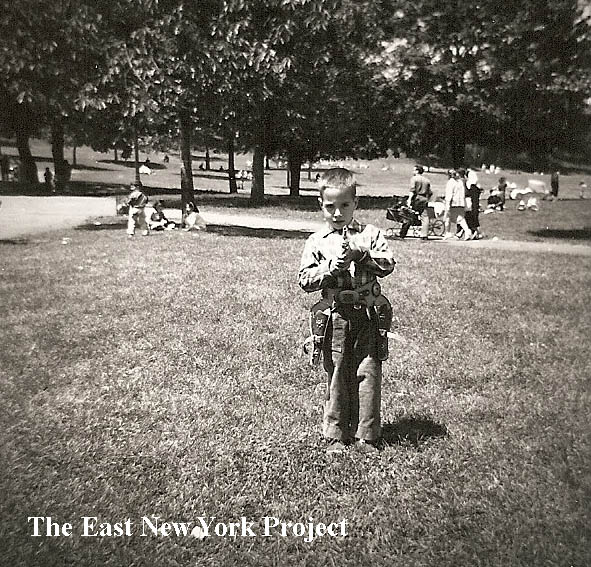 |
 |
You don't find many cowboys in Highland Park, Robert Iannotta's 1960 shot of himself appears to be taken behind the oval towards the ballfields. On the right, Ronnie Amerise provides a shot of his sister Rose in 1945. Note here and in the pictures below how sparse the trees were in that area once. |
 |
 |
Highland Park, 1939 and 1948 June Marmo now has our earliest Highland Park family photo contribution; that first photo is June in 1939. Note the young trees in the background. |
 |
 |
Highland Park, 1949. On the left, from Dan Bivona, a shot of Dan and his parents in 1949. On the right, a contribution from Joe Sadauskas circa 1949. |
 |
Warwick St. Entrance, 2005 Swinging all the way back to the west, this strip of the park on the left was used by us for baseball. The path into the park used to be cobblestone and we would lift a few stones for bases. You batted "uphill" and fielding grounders was a challenge as a huge rut ran down the center of the field caused by water runoff. Throws home were also an adventure as it was all downhill and errant throws could bounce all the way to Jamaica Ave. The path into Sunnyside had a wrought iron fence which made for a perfect home run fence. If we didn't have enough guys it was a good space for "Flies Up". Later on we used the space for 2 of our "Olympic" field events; the "Bocci Ball Toss" and the "Broomstick Throw". |
|
 |
 |
Some underexposed photos from 1973 showing the steps leading up to the Upper park from the west side, and the view from the top. |
 |
Gloria (Profeta) Gallaway provided this shots from the 1950s. Though I don't recognize the stone wall, Gloria identified the location as near these steps leading up to Highland Boulevard on the west side of the park. Ronnie Amerise confirmed there were several of these behind the handball courts at one time as retaining walls. | |